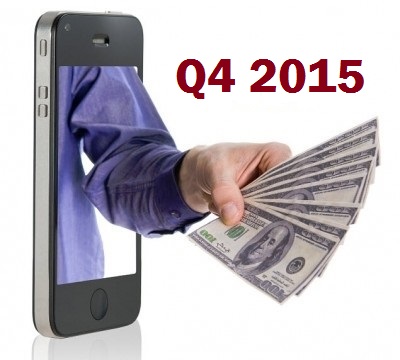The Adyen research firm has now released their figures which showed smartphones surpassed tablets in m-payments.
For the first time in the history of mobile payments, the last quarter of 2015 represented the time when smartphones were used more often than tablets for the completion of transactions that were made online.
At the same time, it remained iPads that were able to bring in the largest average transaction value.
The figures from Adyen, a research company, have also revealed that in the last three months of 2015, one in three online transactions were carried out in the form of mobile payments. The purchases were made either by way of a smartphone or a tablet. More specifically, 34 percent of online transactions during the last quarter of 2015 were completed over mobile. This was a solid increase over the third quarter of last year, when that figure had been 30 percent.
Mobile payments are currently divided nearly equally between smartphones and tablets, though phones are growing.
 In the worldwide scene, smartphones are being used for 17.5 percent of all purchase transactions completed online. This is an increase over the previous quarter, when it had been 14 percent. Comparatively, tablets were used 16 percent of the time, which is a decrease when compared to the quarter before, when it had been 17 percent.
In the worldwide scene, smartphones are being used for 17.5 percent of all purchase transactions completed online. This is an increase over the previous quarter, when it had been 14 percent. Comparatively, tablets were used 16 percent of the time, which is a decrease when compared to the quarter before, when it had been 17 percent.
What Adven determined was that even though smartphones were rising in popularity, it remained iPads that were being used for the transactions that had the highest overall total value. The average order value over iPads was $107. In second place – and only very slightly behind iPads – were orders made over laptops and PCs, as their average order value was $106. Android tablets took third place with $86, iPhones were in fourth place at $83 and, finally, Android smartphones had an average total purchase value of $73.
According to Roelant Prins, the chief commerce officer at Adven, in a recent statement, “Mobile payments, both in app and browser-based, are driving the growth of eCommerce, and this trend is particularly noticeable by the acceleration in mobile payments for methods such as JCB and Alipay.”
Many consumers are turning to their mobile devices to get their shopping and banking done
Mobile payments have become quite popular in South Korea. The country is home to one of the most expansive mobile Internet infrastructures in the world and many consumers have begun to exploit the Internet speeds they have access to in order to get their shopping done quickly. A new report from the Bank of Korea shows that consumers are beginning to favor their mobile devices when shopping online, largely due to the convenient nature of mobile commerce.
Bank of Korea report shows that one in six consumers turn to mobile payments
According to the report from the Bank of Korea, one in six South Korean consumers have made use of a mobile payments service. The report shows that most consumers make use of these services once to three times a month. Approximately 23% of consumers reported that they use mobile payments services at least once a month, with another 23% reporting that they use these services much more frequently; at least once or twice a week. With more consumers becoming involved in mobile commerce, many businesses may find new opportunities to effectively engage these potential customers.
Demand for secure and reliable services continues to rise in South Korea
 Bank of Korea suggests that organizations should improve their mobile banking operations in order to effectively engage consumers on smartphones. In improving these operations, organizations should focus on two aspects of the mobile commerce world: Security and reliability. The demand for reliable mobile payments services and new banking services is growing, creating opportunities for financial service instructions that may result in economic success. Organizations will also have to ensure that the services they offer are capable of adequately protecting consumer information.
Bank of Korea suggests that organizations should improve their mobile banking operations in order to effectively engage consumers on smartphones. In improving these operations, organizations should focus on two aspects of the mobile commerce world: Security and reliability. The demand for reliable mobile payments services and new banking services is growing, creating opportunities for financial service instructions that may result in economic success. Organizations will also have to ensure that the services they offer are capable of adequately protecting consumer information.
Security remains a priority for companies involved in mobile commerce
Security is, perhaps, the most important issue to address. Many consumers have avoided using mobile payments services because they worry that their information may be exposed to significant risks. Companies involved in the mobile payments space have been working to allay fears concerning security through the introduction of new technology. New services with more robust security features are becoming available as a result.
 In the worldwide scene, smartphones are being used for 17.5 percent of all purchase transactions completed online. This is an increase over the previous quarter, when it had been 14 percent. Comparatively, tablets were used 16 percent of the time, which is a decrease when compared to the quarter before, when it had been 17 percent.
In the worldwide scene, smartphones are being used for 17.5 percent of all purchase transactions completed online. This is an increase over the previous quarter, when it had been 14 percent. Comparatively, tablets were used 16 percent of the time, which is a decrease when compared to the quarter before, when it had been 17 percent.
 Bank of Korea suggests that organizations should improve their mobile banking operations in order to effectively engage consumers on smartphones. In improving these operations, organizations should focus on two aspects of the
Bank of Korea suggests that organizations should improve their mobile banking operations in order to effectively engage consumers on smartphones. In improving these operations, organizations should focus on two aspects of the 